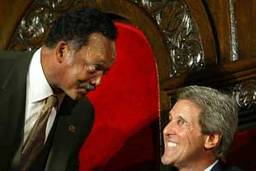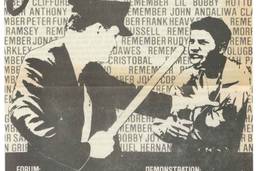Last April, the Children’s Defense Fund reported that more than 1 million African-American children live in “deep poverty,” in households with incomes less than half the U.S. government’s already inadequate poverty level. This is up dramatically from early 2000, when “only” 686,000 black children were that poor—an accomplishment certain to be deleted from George W. Bush’s re-election résumé. The story of this report received a short burst of attention, meriting mention in the New York Times and other mainstream venues before it quickly faded.
The coverage given to this story was soon eclipsed by the revelation that leading right-wing moral-crusader, Republican political strategist, and educational magnate William J. Bennett was a serious problem gambler. According to various reports, Bennett, a onetime secretary of education, and past chairman of the National Endowment for the Humanities, was a casino owners’ dream who lost more than $8 million playing Las Vegas slot machines during the last decade alone. Americans were shocked and in some cases delighted to learn that the nation’s leading preacher of virtue was incapable of reining in his compulsion to “cycle” massive amounts of surplus wealth through the slot- and video-game machinery of Las Vegas and Atlantic City.
The first chapter of Bennett’s bestseller The Book of Virtues: A Treasury of Moral Stories, a compilation of morally instructive tales written specifically for children, is titled “Self-Discipline.” “There is much unhappiness and personal distress in the world,” Bennett writes in that chapter’s introduction, “because of failures to control and temper appetites, passions, and impulses.” The second chapter is titled “Compassion.” Compassion “comes close to the very heart of moral awareness, to seeing in one’s neighbor another self.” “Treat no one,” Bennett instructs, “with callous disregard.”
Too bad Bennett and his Republican ilk don’t see the need to cycle a few more million (or better yet, billion) dollars worth of enrichment through the bodies and minds of America’s growing number of “deeply” poor black children, who are now proclaimed even more irrelevant than usual in the face of America’s virtuous effort to “liberate” Iraq, to the great “collateral” advantage of Halliburton, Bechtel, and other needy subjects lining up for their share of the general welfare. Talk about your “callous disregard.”
How darkly appropriate, then, to read the title of a recent article criticizing Bennett and Bush’s educational ideas and policies, which work to undercut the nation’s core commitment to public schooling: “Gambling with the Children.” How fitting to learn from sociologist David Nibert that legalized gambling is a “fiscal shell game” whereby state governments pretend to boost school spending while cutting or merely maintaining already inadequate funding streams for the nation’s disproportionately black and Hispanic public schools.
How sad, too, to see the mainstream discussion of Bennett’s nasty little habit discussed in isolation from social facts and stuck at the Charles Dickens level, arguing in bourgeois-moralist terms about the propriety of a rich man’s behavior. Mainstream commentators had nothing to say about the deeper immorality involved in the creation and maintenance of a social structure whereby one such man can afford to entertain himself by dropping in machines a sum greater than the lifetime earnings of most of his fellow citizens.
————–
None of this irony, we can be sure, was surprising to Henry Giroux. For more than two decades, Giroux has combined left social, cultural, and educational theory to defend American children, public education, and democracy against the depredations of American racism and corporate capitalism. The result is a prolific body of morally engaged scholarship, spread over more than 25 books citing an impressive range of empirical and theoretical sources. Beneath this remarkable outpouring lies a simple concern with the predicament of youth. The truest measure of America’s performance as a democratic society, Giroux argues, “is the condition of its children.”
By this standard, America is a dismal failure, with too many American children living poorly, without decent housing and health care, attending decrepit, under-funded schools, and subjected to a hopelessness-inducing onslaught of reactionary pedagogy within and beyond school walls. Giroux’s latest book, The Abandoned Generation: Democracy Beyond the Culture of Fear, provides a horrifying catalogue of forces assaulting youth, poor and minority youth in particular, in the post-9/11 era.
Those forces include the ascendancy of a “belligerent nationalism” that constructs community on the basis of fear and mindless conformity rather than democratic possibility. This dominant right-wing patriotism cultivates a climate of permanent public emergency to “remove the application of government power from the fields of ethical and political responsibility.” It “confuses dissent with treason,” democracy with capitalism, freedom with consumerism, culture with commercialism, and justice with brute force. It is incapable of imagining meaningful collective human experience outside the realms of private and commodified experience, proclaiming that “social problems can only be addressed through private solutions.” It “collapses the [very] idea of the social under the weight of a market philosophy that … views community as an obstacle to market-based values, that stresses excessive individualism, privatization, commercialization and the bottom line.”
Increasingly stripped of its social-democratic “helping functions” and reduced to its expanding “policing” role, the American public sector is being transformed into a repressive “garrison state.” It acts as little more than the authoritarian agent of capital’s dictates, replacing compassion with repression and criminalizing social problems that result from the deepening of socioeconomic and related racial inequalities. It generates racially disparate mass incarceration and a savage assault on domestic civil liberties and a preference for military intervention over humanitarian assistance abroad.
————–
This is bad for most Americans. It is especially bad for the nation’s youth, particularly poor and minority kids, increasingly turned into raw material for the burgeoning, expensive, and taxpayer-financed prison- and military-industrial complexes. These hypervulnerable segments of the population are targeted by capitalism’s wider attack on institutions and organizations that have traditionally provided support for children’s rights: public and private welfare agencies, labor unions, churches, public education, and the family. They are directly assaulted by the Bush educational agenda, a powerful attack on the core democratic essence of public schooling. With its lockstep emphasis on standardized testing, “drill-and-skill” teaching, and what it calls “parental choice”—the right of relatively privileged parents to escape failed public schools to private schools with vouchers that steal funds from already under-financed schools—the Bush plan promotes a “culture of failure” among minority kids. Many of these lack the “cultural and academic resources” to negotiate “the high-stakes sorting mechanisms of a state- and corporate-regulated testing machine.”
At the same time, the Bush agenda pre-empts teachers’ capacity to cultivate critical thinking, enlisting them as agents of the corporate state rather than civic democracy. It deepens existing racial and related socioeconomic inequalities since “standardized tests have always favored the rich and powerful” and would be immediately suspended the minute they began to work to the advantage of the marginal and nonaffluent. Those who don’t accommodate this reactionary, narrow-minded pedagogical regime are passed on to the criminal justice system in the authoritarian, all-or-nothing name of “zero tolerance.”
American youth’s predicament is worsening also in what Giroux calls “Higher Education, Inc.,” itself increasingly absorbed into the corporate, neoliberal agenda. The means of academia’s corporatization include the ascendancy of bottom-line (profit-loss) measurements of academic “efficiency,” endemic use of superexploited adjunct and temporary faculty labor (“creating a permanent underclass of professional part-time workers in higher education”), the spread of digital “distance education,” and a growing assault on faculties’ intellectual property rights. It doesn’t help, Giroux adds, that “many left and liberal academics have retreated into an arcane discourse that offers them mostly the safe ground of the professional recluse” and does little to inspire their students and nurture critically engaged and democratic citizenship.
There are grave pedagogical problems, last but not least, in the corporate-crafted “popular” culture, where young Americans actually receive the lion’s share of their educational disempowerment. To illustrate this point, Giroux shows how two recent American movies hailed for authentically representing the experience of alienated American teenagers (Ghost World and Baby Boy) “seal off issues of identity, power, and cultural difference” from any discernible relationship to problems of social structure and public politics. Both films sever the deep connection between individual pain and “public discontents,” epitomizing neoliberal capitalism’s radically privatized understanding of social experience.
————–
What is to be done? Giroux aims his recommendations mainly at educators, journalists, and other “cultural workers.” Intellectuals, Giroux contends, “represent the conscience of society.” Their role is vital because they “shape the conditions under which future generations learn about themselves and their relations to the outside world” and “engage questions that are by their very nature moral and political rather than simply cost-effective and technical.” Giroux’s main counsel is that educators, scholars, and policymakers work to “revitalize a language of resistance and possibility.” This language “embraces a militant utopianism.” It refuses to “stand still in the face of human suffering,” and recognizes children as society’s most important resource. Giroux concludes by quoting Derrida: “We must do and think the impossible. If only the possible happened, nothing more would happen.”
The right will dismiss Giroux’s analysis and the terms in which they are framed as hysterical or indecipherable hyperbole. Among readers on the left, The Abandoned Generation will elicit admiration but also some grumbling about romantic and “utopian” recommendations. Fine sentiments, some will say, but do intellectuals really “shape the circumstances under which future generations” link private experience to social and political history? Why are so many intellectuals, particularly the academics on whom Giroux seems to count, so indifferent to child-friendly social justice at the end of the day? Passion and theory aside, how precisely are we to build the sorts of organizations and institutions that might create such justice and democracy? To truly revitalize hope we need to outline a coherent, viable political and institutional vision of how to advance and realize radically democratic educational values.
But then, Giroux is hardly the first brilliant, prolific left writer to privilege criticism over prescription. We are indebted to him for penning a rigorous, readable, wide-ranging, and sophisticated description and contextualization of the latest phase in America’s disturbing campaign against its own children.
The coverage given to this story was soon eclipsed by the revelation that leading right-wing moral-crusader, Republican political strategist, and educational magnate William J. Bennett was a serious problem gambler. According to various reports, Bennett, a onetime secretary of education, and past chairman of the National Endowment for the Humanities, was a casino owners’ dream who lost more than $8 million playing Las Vegas slot machines during the last decade alone. Americans were shocked and in some cases delighted to learn that the nation’s leading preacher of virtue was incapable of reining in his compulsion to “cycle” massive amounts of surplus wealth through the slot- and video-game machinery of Las Vegas and Atlantic City.
The first chapter of Bennett’s bestseller The Book of Virtues: A Treasury of Moral Stories, a compilation of morally instructive tales written specifically for children, is titled “Self-Discipline.” “There is much unhappiness and personal distress in the world,” Bennett writes in that chapter’s introduction, “because of failures to control and temper appetites, passions, and impulses.” The second chapter is titled “Compassion.” Compassion “comes close to the very heart of moral awareness, to seeing in one’s neighbor another self.” “Treat no one,” Bennett instructs, “with callous disregard.”
Too bad Bennett and his Republican ilk don’t see the need to cycle a few more million (or better yet, billion) dollars worth of enrichment through the bodies and minds of America’s growing number of “deeply” poor black children, who are now proclaimed even more irrelevant than usual in the face of America’s virtuous effort to “liberate” Iraq, to the great “collateral” advantage of Halliburton, Bechtel, and other needy subjects lining up for their share of the general welfare. Talk about your “callous disregard.”
How darkly appropriate, then, to read the title of a recent article criticizing Bennett and Bush’s educational ideas and policies, which work to undercut the nation’s core commitment to public schooling: “Gambling with the Children.” How fitting to learn from sociologist David Nibert that legalized gambling is a “fiscal shell game” whereby state governments pretend to boost school spending while cutting or merely maintaining already inadequate funding streams for the nation’s disproportionately black and Hispanic public schools.
How sad, too, to see the mainstream discussion of Bennett’s nasty little habit discussed in isolation from social facts and stuck at the Charles Dickens level, arguing in bourgeois-moralist terms about the propriety of a rich man’s behavior. Mainstream commentators had nothing to say about the deeper immorality involved in the creation and maintenance of a social structure whereby one such man can afford to entertain himself by dropping in machines a sum greater than the lifetime earnings of most of his fellow citizens.
————–
None of this irony, we can be sure, was surprising to Henry Giroux. For more than two decades, Giroux has combined left social, cultural, and educational theory to defend American children, public education, and democracy against the depredations of American racism and corporate capitalism. The result is a prolific body of morally engaged scholarship, spread over more than 25 books citing an impressive range of empirical and theoretical sources. Beneath this remarkable outpouring lies a simple concern with the predicament of youth. The truest measure of America’s performance as a democratic society, Giroux argues, “is the condition of its children.”
By this standard, America is a dismal failure, with too many American children living poorly, without decent housing and health care, attending decrepit, under-funded schools, and subjected to a hopelessness-inducing onslaught of reactionary pedagogy within and beyond school walls. Giroux’s latest book, The Abandoned Generation: Democracy Beyond the Culture of Fear, provides a horrifying catalogue of forces assaulting youth, poor and minority youth in particular, in the post-9/11 era.
Those forces include the ascendancy of a “belligerent nationalism” that constructs community on the basis of fear and mindless conformity rather than democratic possibility. This dominant right-wing patriotism cultivates a climate of permanent public emergency to “remove the application of government power from the fields of ethical and political responsibility.” It “confuses dissent with treason,” democracy with capitalism, freedom with consumerism, culture with commercialism, and justice with brute force. It is incapable of imagining meaningful collective human experience outside the realms of private and commodified experience, proclaiming that “social problems can only be addressed through private solutions.” It “collapses the [very] idea of the social under the weight of a market philosophy that … views community as an obstacle to market-based values, that stresses excessive individualism, privatization, commercialization and the bottom line.”
Increasingly stripped of its social-democratic “helping functions” and reduced to its expanding “policing” role, the American public sector is being transformed into a repressive “garrison state.” It acts as little more than the authoritarian agent of capital’s dictates, replacing compassion with repression and criminalizing social problems that result from the deepening of socioeconomic and related racial inequalities. It generates racially disparate mass incarceration and a savage assault on domestic civil liberties and a preference for military intervention over humanitarian assistance abroad.
————–
This is bad for most Americans. It is especially bad for the nation’s youth, particularly poor and minority kids, increasingly turned into raw material for the burgeoning, expensive, and taxpayer-financed prison- and military-industrial complexes. These hypervulnerable segments of the population are targeted by capitalism’s wider attack on institutions and organizations that have traditionally provided support for children’s rights: public and private welfare agencies, labor unions, churches, public education, and the family. They are directly assaulted by the Bush educational agenda, a powerful attack on the core democratic essence of public schooling. With its lockstep emphasis on standardized testing, “drill-and-skill” teaching, and what it calls “parental choice”—the right of relatively privileged parents to escape failed public schools to private schools with vouchers that steal funds from already under-financed schools—the Bush plan promotes a “culture of failure” among minority kids. Many of these lack the “cultural and academic resources” to negotiate “the high-stakes sorting mechanisms of a state- and corporate-regulated testing machine.”
At the same time, the Bush agenda pre-empts teachers’ capacity to cultivate critical thinking, enlisting them as agents of the corporate state rather than civic democracy. It deepens existing racial and related socioeconomic inequalities since “standardized tests have always favored the rich and powerful” and would be immediately suspended the minute they began to work to the advantage of the marginal and nonaffluent. Those who don’t accommodate this reactionary, narrow-minded pedagogical regime are passed on to the criminal justice system in the authoritarian, all-or-nothing name of “zero tolerance.”
American youth’s predicament is worsening also in what Giroux calls “Higher Education, Inc.,” itself increasingly absorbed into the corporate, neoliberal agenda. The means of academia’s corporatization include the ascendancy of bottom-line (profit-loss) measurements of academic “efficiency,” endemic use of superexploited adjunct and temporary faculty labor (“creating a permanent underclass of professional part-time workers in higher education”), the spread of digital “distance education,” and a growing assault on faculties’ intellectual property rights. It doesn’t help, Giroux adds, that “many left and liberal academics have retreated into an arcane discourse that offers them mostly the safe ground of the professional recluse” and does little to inspire their students and nurture critically engaged and democratic citizenship.
There are grave pedagogical problems, last but not least, in the corporate-crafted “popular” culture, where young Americans actually receive the lion’s share of their educational disempowerment. To illustrate this point, Giroux shows how two recent American movies hailed for authentically representing the experience of alienated American teenagers (Ghost World and Baby Boy) “seal off issues of identity, power, and cultural difference” from any discernible relationship to problems of social structure and public politics. Both films sever the deep connection between individual pain and “public discontents,” epitomizing neoliberal capitalism’s radically privatized understanding of social experience.
————–
What is to be done? Giroux aims his recommendations mainly at educators, journalists, and other “cultural workers.” Intellectuals, Giroux contends, “represent the conscience of society.” Their role is vital because they “shape the conditions under which future generations learn about themselves and their relations to the outside world” and “engage questions that are by their very nature moral and political rather than simply cost-effective and technical.” Giroux’s main counsel is that educators, scholars, and policymakers work to “revitalize a language of resistance and possibility.” This language “embraces a militant utopianism.” It refuses to “stand still in the face of human suffering,” and recognizes children as society’s most important resource. Giroux concludes by quoting Derrida: “We must do and think the impossible. If only the possible happened, nothing more would happen.”
The right will dismiss Giroux’s analysis and the terms in which they are framed as hysterical or indecipherable hyperbole. Among readers on the left, The Abandoned Generation will elicit admiration but also some grumbling about romantic and “utopian” recommendations. Fine sentiments, some will say, but do intellectuals really “shape the circumstances under which future generations” link private experience to social and political history? Why are so many intellectuals, particularly the academics on whom Giroux seems to count, so indifferent to child-friendly social justice at the end of the day? Passion and theory aside, how precisely are we to build the sorts of organizations and institutions that might create such justice and democracy? To truly revitalize hope we need to outline a coherent, viable political and institutional vision of how to advance and realize radically democratic educational values.
But then, Giroux is hardly the first brilliant, prolific left writer to privilege criticism over prescription. We are indebted to him for penning a rigorous, readable, wide-ranging, and sophisticated description and contextualization of the latest phase in America’s disturbing campaign against its own children.
Please consider supporting our work.

I hope you found this article important. Before you leave, I want to ask you to consider supporting our work with a donation. In These Times needs readers like you to help sustain our mission. We don’t depend on—or want—corporate advertising or deep-pocketed billionaires to fund our journalism. We’re supported by you, the reader, so we can focus on covering the issues that matter most to the progressive movement without fear or compromise.
Our work isn’t hidden behind a paywall because of people like you who support our journalism. We want to keep it that way. If you value the work we do and the movements we cover, please consider donating to In These Times.







